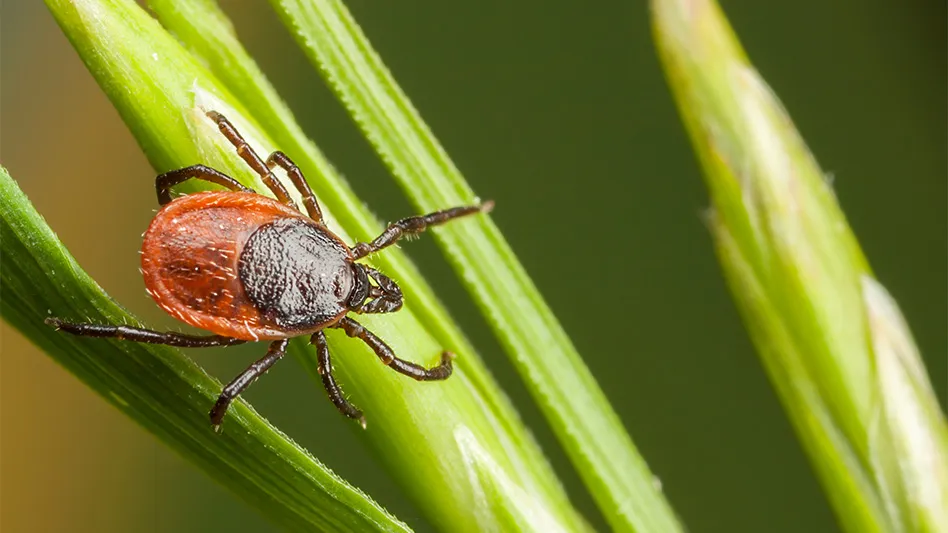The discovery of synthetic pesticides in the 1940s has been a boon to mankind's conflicts with insect pests over the past 50 years. Much has been learned about the proper use of these chemicals and how they can be used more effectively and judiciously. In the world of structural pest management, the array of available pesticides and pesticide formulations are more varied than they might be in agriculture. Thus, the urban pest management professional must make a number of choices in each pest situation. This article will discuss the factors affecting one of those choices when a dust insecticide is the best selection for a particular pest situation.
FORMULATION FACTORS. Any insecticide can be manufactured in a number of types of formulations. For example, chlorpyrifos is available in at least eight different, commonly used formulations in our industry, and each of these formulations may be right for different types of treatment sites. Some of the factors affecting which insecticide formulation to choose include:
• The type of surface to be treated.
• The conditions present at the treatment site for example, wet or dry.
• The type of treatment technique selected.
• The type of equipment needed for the treatment.
• Any concerns about detectable chemical odors.
Each of these has a bearing on which formulation type will be the best choice for a particular treatment. Within the same room, a pest management professional may need to use two or even three different formulations to achieve the best results for his or her customer.
BENEFITS OF DUSTS. A dust insecticide has many advantages over other types of formulations in treating structural pest infestations. Among them:
• Much longer residual life.
• Ease of application.
• Lower cost.
• Good coverage on surfaces.
• Ease of attachment to an insect's legs and body.
• Low to no odor.
Where do many of the pests encountered in buildings live and hide? In cracks and voids, of course, especially cockroaches, crickets, ants, and occasional invaders. A dust insecticide is the ideal choice for treating cracks and voids because it is easier to achieve complete coverage of surfaces inside the crack or void. A dust also lasts a long time in dry, undisturbed cracks and voids, and it is easily picked up by insects as they walk across treated surfaces.
DUST DRAWBACKS. A dust is not designed to treat exposed surfaces, except in areas that are inaccessible or are rarely entered, such as an attic or a crawl space. Even in these areas, a dust should not be indiscriminately broadcast, but should be targeted to specific cracks, voids or surfaces where insect pests are most likely to be found.
Most dusts are not effective in wet areas and can be rendered ineffective when a treated dry crack or void becomes wet. One new dust recently introduced, DeltaDust, is designed to work in wet areas, and would be the choice to treat cracks and voids which may become wet. Unfortunately, at this time DeltaDust is not labeled for use in commercial food areas where most situations involving wet cracks and voids are encountered. Once this dust receives its food area labeling, it will be an excellent choice for treating in dishwasher areas and similar wet areas in commercial kitchens.
Voids that contain insulation do not permit good penetration of dust throughout the void. Some pest management professionals, however, have had success applying Drione dust and other small particle dusts in insulated voids using a compressed air duster or an electric duster designed specifically to treat cracks and voids.
TYPES OF DUSTS. Two types of dusts are used in pest control work: inorganic dusts and organic dusts. Inorganic dusts are derived from sources within the earth and do not break down. Organic dusts are man-made and will break down and become ineffective after a number of months. The inorganic dusts boric acid, silica a gel and diatomaceous earth conceivably can kill insects upon contact for years after application if the area remains dry.
• Boric Acid. Boric acid is an inorganic dust that is available under a number of trade names and at different percentages. For example, Borid contains 99% boric acid, while Zone Defense uses an inert carrier to dilute the boric acid to 64% The percentage does not really matter in how well the dust product will work in killing insects 40% kills just as well as 99%.
Boric acid is a stomach poison and also has some action as an abrasive. It is best used against insects that groom themselves constantly, such as cockroaches. It is a slow-acting material that takes seven to ten days to kill, so avoid using it on an initial service when immediate results are required.
• Borates. Two insecticides are available that contain the inorganic insecticide disodium octaborate tetrahydrate; they are commonly referred to simply as "borates." Both Tim-bor and Bora-Care are usually mixed in water for application to wood surfaces, but Tim-bor concentrate may be applied as a dry dust into termite and carpenter ant galleries and into cracks for controlling cockroaches, silverfish and other pests.
• Drione Insecticide. Drione is a widely used insecticide dust that contains pyrethrins, piperonyl butoxide (PBO), and silica aerogel. After application, the pyrethrins and PBO degrade after a couple of weeks, leaving the inorganic silica aerogel behind. The inorganic silica aerogel will remain effective indefinitely unless it is removed or it gets excessively wet. Silica aerogel is repellent to many insects and is excellent for treating cracks and voids that are difficult to reach and treat. This repellency forces insects to harbor in easier-to-reach cracks and voids. Drione produces quick flushing action and quicker kill due to the presence of the pyrethrins and PBO. After these two insecticides degrade, however, the silica aerogel left behind may take a number of days to kill after contacting an insect.
• DriDie. DriDie is composed only of silica aerogel and is used in sensitive situ ations where organic insecticides cannot be used. Such situations include some areas of hospitals, zoos, and animal research centers.
• Diatomaceous Earth. This insecticide is made of the fossilized bodies of microscopic organisms and is mined from the earth. Like silica aerogel, it acts as an abrasive and a desiccant and takes a number of days to kill an insect. It is available in a number of different products and, like Drione, may be combined with pyrethrins and piperonyl butoxide.
• Ficam D. Ficam D is an organic dust that contains bendiocarb and is especially effective in controlling hymenopterous insects such as ants, bees, and wasps. It will remain effective for several months in dry cracks and voids, but after that, additional applications may be necessary.
• Tempo Dust. The first synthetic pyrethroid insecticide to be marketed to the pest control industry, Tempo Dust contains cyfluthrin. This dust is effective against a wide variety of insects, including German cockroaches, and has good flushing and knockdown activity. Like other organic dusts, it will lose effectiveness after several months.
• DeltaDust. DeltaDust contains the synthetic pyrethroid deltamethrin and is another organic dust. As mentioned before, it is effective in wet areas because it is water-repellent, but it has a limited residual life. • Other Organic Dusts. Dusts containing Dursban, Diazinon, and Sevin are also available, although they are not widely used in structural pest control situations.
APPLYING DUSTS. Any dry crack or void where insects are living or hiding is a candidate for treatment with a dust insecticide. For maximum effectiveness, dust insecticides must be applied properly. The following tips should provide the desired results when using a dust.
• Dusts work best when applied lightly. Heavy dust layers repel insects, and unless they contact the dust, they will not be killed.
• The duster should never be filled more than half full with dust. Dusts require air in the duster to pick up dust particles and carry them out the tip of the duster into the crack or void. If the duster is too full, clumps of dust will be applied. This results in overapplication and spills that have to be cleaned up.
• Each different dust requires a differ ent, properly labeled hand duster. Having properly labeled hand dusters will prevent using the wrong dust insecticide.
• Small hand dusters should be stored inside a zip-lock bag in the event that dust accidentally leaks out the duster's tip. Label this bag with the type of dust used in the duster.
• Before application, shake the duster to get dust floating in the air inside the duster. Applying the dust then requires only slight squeezing movements with the hand. The larger the crack or void being treated, the harder the squeezing that will be necessary to force dust to all areas within the crack or void.
• Carry a small brush and a damp cloth. Even the most careful and skilled dust applicator will occasionally end up with dust accidentally drifting out of a crack onto nontarget surfaces. Excess dust can be brushed back into cracks or can be removed with a damp cloth.
CONCLUSION. Dusts are the ideal formulation for any situation in which pests are living in dry cracks or voids. The use of inorganic dusts in these areas reduces the need for frequent retreatment, which saves time during future preventive services. Dusts, however, are not the best choice for every situation.
The type of dust chosen will depend on the target pest, the site being treated, and the type of area such as a commercial kitchen. Used correctly, dusts are one of the best tools available to the pest management professional.
PCT Contributing Author Stoy A. Hedges is manager of technical services for Terminix International, Memphis, Tennessee.

Explore the June 1996 Issue
Check out more from this issue and find you next story to read.
Latest from Pest Control Technology
- Ground Control
- Scientists, PMPs Collaborating to Map Termite Distribution in Southern U.S.
- Viking Pest Control Organizes a Charity Bike Build for Local Families
- Gaining Control of Structure-Infesting Carpenter Ants
- Big Blue Bug’s Brian Goldman Receives Rhode Island Small Business Person of the Year Award
- UF Researchers Examine How Much Bait it Takes to Eliminate a Subterranean Termite Colony
- Women in Pest Control Group Continues to Grow, Provide Opportunities in the Industry
- NPMA Announces Results of 2024-2025 Board of Directors Election





